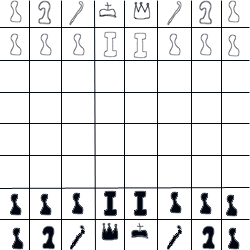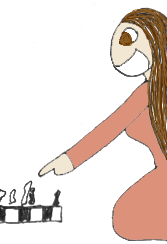

In Strip #209, we see the beginning of a storyline where Aylia decides to create her own rules for chess. Well, after months of deliberation, I decided to flesh those rules out completely, and then post them online for all to see. I've played the game with these rules before, and it seems to be fairly balanced. So here we have a special extra,
Aylia's Rules for Chess.
1. At the start of the game, you may designate one of your bishops to be a wizard. If you do (and you don't have to), the type of magic that wizard can use will depend on the color of the square they start on. Wizards that start on white squares are white wizards, and wizards that start on black squares are black wizards. Black wizards use black magic, and white wizards use white magic. Black magic is used to affect the other player's pieces, and white magic is used to affect your own.
2. If you choose to play chess with Aylia's rules, some of the pieces will move differently than in normal chess. Here are the way pieces move (and her reasoning behind it):
KING: One space in any direction (same as usual).
Reason: That would be just like Uncle Richard.
QUEEN: As many spaces as she wants in any direction (same as usual).
Reason: It makes sense; Aunt Tilia's the intelligence behind the throne.
BISHOP: Any number of spaces along a diagonal path (same as usual).
Reason: They're ordinary, so they'll act like normal.
WIZARD: No movement at all, and no taking pieces.
Reason: They have to cast spells -- they don't have time to worry about other things.
HORSE: In an L-shape any direction (same as usual).
Reason: Horses aren't that bright, but they can do interesting things sometimes.
CASTLE: One space in any direction, cannot take pieces, but also cannot be taken.
Reason: Castles are defense fortifications -- they don't go charging off into battle.
NOTE: If you lose your wizard, your castles will no longer be able to move. And horses can't jump over castles.
3. At the start of the game, you must designate one of your pawns to be the crown prince, and you may also designate one to be a princess, though this is not required. The crown prince will be one of your pawns in the back corners (see the game board arrangement in Rule #4). The princess (if you choose to have one) has her identity kept secret, so you do not reveal it to the enemy (you should write down which she is, in case you need to prove her identity later), but she can be any of the other pawns. The rest of the pawns are servants. Here is how each piece moves:
SERVANT: One space in a forward direction, takes diagonally (same as usual).
Reason: They can be sort of useful sometimes, but not often.
PRINCESS: Moves like a servant, but if taken, the queen cannot move for the next five rounds.
Reason: The queen's going to be wild with grief if her daughter's captured.
CROWN PRINCE: Can move one space forward or backward, can take pieces diagonally, forwards or backwards.
Reason: The crown prince is a little more intelligent than the servants -- and he'd be thrilled to go back home, instead of closer to enemy strongholds.
NOTE: The princess (if you have one) is the only servant that may become a queen when she reaches the other side of the board, and she becomes the queen only if your queen has already been captured. Even if you have no princess, servants cannot be promoted.
4. The pieces are arranged slightly differently at the start of the game. This is what the game board looks like:
 |
 |
 |
